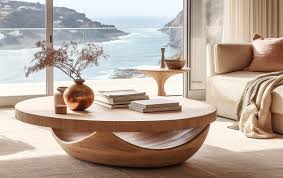In the realm of cabinetwork, many pieces are as adaptable and essential as the coffee table. Nestled in living apartments, couches, and occasionally even out-of-door spaces, the coffee table serves as a functional face and a focal point that ties together a room, reflecting history and purpose. Its elaboration from a simple mileage item to a design statement shows homeowners’ changing tastes and cultures throughout history.
Origins and Evolution
The conception of a low, vertical table designed specifically for holding refreshments dates back centuries. In ancient societies like the Egyptians and Banquettes, low tables served tea snacks or placed important vestiges and jottings. The term coffee table, as we know it, surfaced in the late 19th century during the Puritan period, when tea-drinking culture was at its peak in Europe.
Initially, coffee tables were small, portable pieces placed near seating arrangements to hold mugs and goblets. They were frequently made of wood and adorned with intricate busts or inlays, reflecting the deception of the time. As social gatherings and the concept of the living room became more popular in the early 20th century, the coffee table became fashionable as a centerpiece of home decor.
Functionality and Design
Ultramodern coffee tables come in various shapes, sizes, and arrangements to suit different tastes and functional requirements. Blockish tables remain the most common, befitting neatly in front of settees and furnishing ample face area for drinks, books, and ornamental particulars. Indirect and round tables offer a softer aesthetic and are ideal for lower spaces or to produce a cozy seating arrangement.
Accouterments range from traditional forestland like oak, walnut, and mahogany to more contemporary choices like glass, essence, and tempera. Each material contributes its own aesthetic appeal and practical benefits. For illustration, a glass coffee table can make a room feel more spacious and airy, while a solid wood table adds warmth and texture.
Design Trends and Styles
The design of coffee tables has evolved significantly to reflect changing trends in interior design. Mid-century ultramodern tables, characterized by clean lines and minimalistic forms, remain popular for their dateless appeal and functionality. Scandinavian-inspired designs emphasize simplicity and functionality with natural wood homestretches and satiny, understated lines.
Contemporary coffee tables frequently blend accouterments similar to wood and essence or incorporate unconventional shapes and homestretches to make a bold statement. Floating tables with retired storehouse chambers feed practical requirements without compromising style, while modular tables allow for inflexibility in arrangement and operation.
Beyond Function Aesthetic Appeal
Beyond their functional part, coffee tables serve as an oil for particular expression and interior styling. They give an occasion to showcase ornamental objects like books, vases, and puppets that reflect the homeowner’s personality and interests. A well-chosen coffee table can tie together distant rudiments in a room, creating a cohesive and inviting atmosphere.
The rise of online platforms and interior design influencers has further elevated the significance of coffee tables in home scenery. Social media feeds are replete with inspirational images of beautifully nominated coffee tables, encouraging homeowners to experiment with different textures, colors, and arrangements.
Practical Considerations
Practical considerations such as size, height, and continuity are pivotal when choosing a coffee table. The table should round the scale of the seating area without overwhelming it. Immaculately, it should be about the same height as the seat cocoons or slightly lower for easy reach.
For homes with youthful children or favorites, rounded edges, and sturdy construction are important safety considerations. Also, concluding accouterments that are easy to clean and maintain ensure life and preserve the table’s aesthetic appeal over time.
Conclusion
In conclusion, the humble coffee table has evolved from a simple serving face to a multifunctional piece of cabinetwork that anchors living spaces and reflects a particular style. Whether chosen for its practical mileage, aesthetic appeal, or both, the coffee table remains a necessary element of ultramodern interior design. Its capability to acclimatize to changing trends while maintaining its essential role as a gathering place for families and musketeers ensures its enduring fashionability in homes worldwide.

